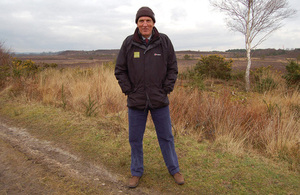Conservation covenants can help protect our landscapes
Conservation covenants could allow landowners to protect their environment in perpetuity says Andrew Sells, Chairman of Natural England.

Andrew Sells, Chairman of Natural England
The importance of this country’s treasured landscapes to our economy, our health and our sense of identity is perhaps greater now than it has ever been. And yet protecting our natural heritage is often seen as a long-term investment made unaffordable by society’s more pressing day-to-day needs.
I believe there is a way forward that can help landowners and communities to protect the many benefits of the environment for generations into the future.
By using an agreement known as a conservation covenant, landowners in England and Wales could, for the first time, protect their environment not only during their tenure but in perpetuity if they wished.
For example, the owner of some woodland enjoyed by the local community may wish to leave the land to her children. She wants to ensure that the woodland is maintained for public enjoyment but doubts that future generations would share her priorities. A conservation covenant would achieve her aims.
Providing a lasting legacy
A scheme for conservation covenants in England and Wales was recommended by the Law Commission in June last year. A conservation covenant is a voluntary, private agreement between a landowner and a conservation body – such as Natural England or a local wildlife trust - to do or not do something on their land for a conservation purpose. Made in the public interest, it continues to be effective even after the land changes hands. Conservation covenants operate in other countries such as Scotland, USA and Canada, but not yet in England and Wales.
As Chairman of Natural England I have had the privilege of visiting some of our finest landscapes and wildlife sites and have been struck by the generosity and hard work of people who look after these special places for the greater good of mankind and wildlife. Most of them I’m sure would love to know that their endeavours provided a lasting legacy beyond their lifetime.
Of course legal protection of our cherished landscape is nothing new, the biggest stride for conservation in this country coming with the establishment of the National Parks system in 1949. Further legislation, environmentally-friendly farming schemes and the designation of Sites of Special Scientific Interest have all moved things forward. Conservation covenants would augment these essential protections. They would give more conservation powers to those closely connected with the landscape.
Conservation covenants in action
Consider the farmer who has successfully created a species-rich meadow, but fears that later generations might return the land to production - a conservation covenant would avoid this. Such people can identify sites that would otherwise struggle to receive statutory protection, be it a tiny patch of land or a larger area close to a nature reserve; the kind of small link in a bigger chain that helps to create ‘wildlife corridors’, as envisaged by Sir John Lawton in his excellent report ‘Making Space for Nature’. This is grassroots decision-making at its best, providing a community-led approach to conservation.
One thing I keep asking myself is ‘how do we protect farmland, which has delivered environmental gains in return for public money, once that funding ends’? At present these agri-environment schemes provide benefits, such as winter food for birds or wildflower habitat for bees and butterflies, over the course of 10 years. If the landowner wanted to create a longer-term legacy, they could enter into a voluntary conservation covenant and see these benefits run beyond the term of the agri-environment agreement.
Conservation covenants could also be used as alternatives to land purchases by conservation organisations (or used to protect sites when they sell land). They can help the local economy, perhaps by enabling a flood-hit business community to pay a landowner to plant woodland upstream to reduce run-off.
There must, of course, be checks and balances in place, along with some flexibility. If a site can no longer fulfil its original conservation purpose then the current landowner and conservation body could agree to modify or terminate the covenant. And if an area of land covered by a conservation covenant were to be overwhelmingly needed for some other purpose by the community or nation then it could be subject to compulsory purchase.
Conservation covenants are a compelling concept, ensuring that future generations can reap the rewards of our investment in the natural environment.
An abridged version of this article by Andrew Sells appeared in the Times opinion pages on 18 March 2015.